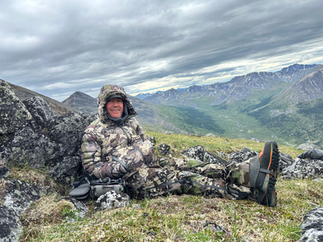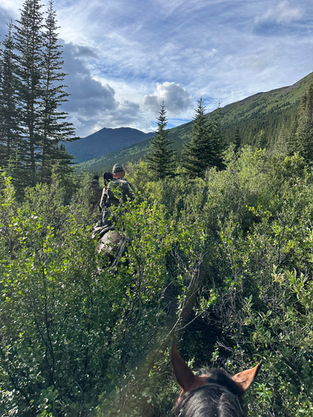This is a grueling hunt in rugged mountains, but it's also really rewarding.
This article was first published in my email newsletter in August of 2025. I've added it to my website, because I think the information is useful in general, not just for the month it was published. If you'd like to keep up with the latest hunting information, including my open dates and available hunts, you can subscribe to my newsletter at the bottom of this page.
When I’m not leading a hunt, the odds are good I’ll be out hunting myself. In particular, I’m an avid sheep hunter, and I just returned from a terrific hunt in Canada, in the Yukon.
I’m working to complete the North American Grand Slam, which includes four animals: Dall Sheep, Stone Sheep, Rocky Mountain Bighorn, and Desert Bighorn. This hunt added the Stone sheep to my collection, which already included the Dall and the Desert Bighorn, so I’m now three-quarters of the way to completing the slam.
HUNTING THE YUKON
This is a grueling hunt.
To appreciate what it’s like, you first need to understand the Yukon. It is huge — about 186,000 square miles, or seventy percent the size of Texas. It’s also rugged and empty — eighty percent of it is hills and mountains, and the population is less than 50,000, which means everybody in the Yukon could fit into the Dallas Cowboy’s AT&T stadium, with almost half the seats still empty. And it’s in the far north, so the sun barely sets at this time of year. During my hunt, I think sunset was at about midnight and the sun was coming back up again at 4 AM.
Ninety percent of the land in the Yukon is public land (called ‘crown’ land in Canada), and any resident of the Yukon can hunt it with an over-the-counter license. Practically speaking, that’s not easy, since the land is so huge — it’s difficult just to get out there and find the game.
If you’re not a resident, you have to go through an outfitter. Outfitters pay the government for a ‘concession’, giving them rights to organize hunts in the area covered by the concession. Concessions don’t exclude Yukon residents, but again, practically speaking, that doesn’t mean much. Sheep in the area I hunted probably hadn’t seen a human being in twenty years.
The Yukon is vast, empty of people, and ruggedly beautiful.
A stone sheep hunt isn’t something you want to undertake if you’re not in great physical condition. It involves hours of horseback riding through dense buck brush, just to get to the mountain you’re hunting; it means living out of a tent and a sleeping bag for however many days it takes to find your sheep; and it means hours spent climbing rugged and rocky mountains with sixty or seventy degree slopes. At the end of a day on those mountains, your legs are jelly, even if you are in good shape.
I was lucky this year. My hunt was relatively short — it lasted five days in total. But that doesn’t count the nineteen days that I spent on the hunt last year, climbing those mountains every day and never seeing a legal ram.
I should mention that I wouldn’t normally do two stone sheep hunts in two years. But I had a good outfitter. He was just as disappointed as I was that I didn’t get a single shot opportunity last year, and he got me scheduled again at the start of the current season, so I could get that opportunity.
Generally, these stone sheep hunts — and most sheep hunts, in fact — are booked out several years in advance, unless you get lucky and catch someone else’s cancellation. But that long lead time is a good thing for most people: Due to demand, the price of stone sheep hunts has risen to $80,000 to $110,000. Most hunters can’t just sit down and write a check for that amount. A three year lead time lets you pay for the hunt in installments. The prices weren’t that high back when I booked my hunt, but I still appreciated being able to make multiple payments.
The base camp had cabins, a cook house, a shower, and a short gravel landing strip for the Cessna 206 that brought me in from Whitehorse.
GETTING THERE AND GETTING STARTED
To get to my hunt, I first flew commercial airlines into Yukon’s capital city, Whitehorse, where more than half the population of the Yukon lives. From there, I flew another half hour or so on a Cessna 206 to our base camp, landing on a short gravel runway.
The base camp was pretty comfortable. It had cabins for the hunter and the staff, a cook cabin, and that always-appreciated hunting luxury, a shower.
I arrived in the base camp a couple of days before the hunting season opened. Opening Day was August 1, and I got to the base camp on July 29. The plan was to spend the 30th scouting, the 31st resting and getting our gear in order, and to then start hunting on the 1st.
I should mention that my outfitters had already done some aerial scouting, and they had located sheep on a mountain that was a four-hour horseback ride from the camp. So we knew there were sheep out there, and we knew on which mountain we would find them.
On the morning of July 30, we headed for the mountain. There were three of us — me; Marius, the guide; and Fin, the wrangler, who took care of the horses. This was an easy day, I guess. We rode for several hours to the base of the mountain, but Marius did the hard work, climbing and glassing for the sheep. He came back down to report that he had found them, so we now knew for sure that this mountain was where we wanted to be on opening day.
Our sheep -- which had been spotted earlier from the air by my outfitter -- were on a mountain that was four hours from the base camp. We rode horseback through dense brush to get there.
THE HUNT BEGAN ON OPENING DAY
The next day, the 31st, was a day to get our gear prepared, to eat some good cooked food, and to rest.
We set out for the mountain at about 6 AM on August 1.
I’ve mentioned before that the ride to the mountain took about four hours. A good share of that was through buck brush that was taller than me. And if you don’t do a lot of horseback riding, four hours in the saddle through buck brush can wear on you.
Climbing to find the sheep took another four hours or so. By mid-afternoon, we had spotted our rams. But we had a problem — they were out of reach across a huge gully. There was no way we could cross that gully — the rams probably could, but not us — and working our way around it would take far too long, so we called it a day.
By the time we got back to the horses — even with the extraordinarily long hours of sun at this time of year — we were about to lose daylight. We ended up riding back in the dark. Thankfully, the horses knew the way. Still, my horse spooked a couple of times. One of those times, he threw me. He bucked me off, all doubled up like a pretzel. On the bright side, maybe that buck brush, which I hated so much, cushioned my fall a bit.
By the time I got to bed, it had been a twenty-three hour day.
Once we reached the mountain, we had some rugged climbing in store. After the first day of the hunt, we decided that the eight hour round trip from the base camp was using too much of our day, so we set up a spike camp.
I GOT MY RAM
The next day, August 2, we decided that we couldn’t continue to spend eight hours a day riding to and from the mountain. We’d need to set up a spike camp. The location wasn’t ideal, because there wasn’t a good source of water nearby, and there wasn’t good foraging for the horses. That meant we had to pack in their food and water.
So this time we had five horses — one for each of us, plus two horses to pack in all the gear, food, and water.
After the usual four-hour ride, we got to the mountain. We took care of the horses, set up camp, and ate a freeze-dried meal. By then — after the tough time we’d had on opening day — I was exhausted. I was asleep by 7:30 PM, hours before the Yukon sunset.
We were up not long after the Yukon sunrise, had some breakfast, and started climbing again. When we got toward the top, we started running along a ridge. The ridge was like a series of benches, each one taller than the one before — a series of steep rises followed by flat shelves. As we got to the top of a rise, we’d glass over the bench, looking for our rams.
Finally, near the peak, Marius crept forward and once again glassed the area. This time, when he came back down to us, he was smiling. The rams were bedded just below the rise — four of them, and more than one of them was at least ten years old, which made them legal. I was finally getting my opportunity.
We climbed up to the top of that rise together. Marius ranged the ram at 243 yards. My rifle — the .280 Ackley I use for international hunts (where suppressors often aren’t legal) -- was zeroed at 200 yards, so I was in good shape.
I got out my bipod and rear shooting bag and got them set up. The ram was downhill from me, so it took a bit of squirming to get positioned just right, but finally I was ready, took off the safety, warned Marius and Fin so they could plug their ears, and broke the trigger.
I had my ram.
That's Fin, our wrangler, posing with me and my ram, and that's Marius, my guide, celebrating with me right before we began climbing down. We came down with everything, including horns, hide, and meat, so we had full packs.
GETTING BACK DOWN
What I hadn’t yet realized was how hard the next step was going to be: getting down off that mountain with a sheep on my back. Before heading down, we skinned the whole animal, because I’m planning for a full, life-size mount. Then we quartered it, too, because under Yukon law you have to take the meat (and in any case, sheep meat is delicious). So we took off the back legs, the shoulders, the ribs, the back straps, the tenders, even the neck meat. The only parts left behind were the hooves, the shin bones, and the spine.
And I should mention, it had started to rain by then. Nothing is easy.
Climbing down the mountain, I was carrying the cape and the horns, and Marius and Fin split up the meat.
We broke down the spike camp, loaded the horses, and started another four hour ride to the base, two hours with daylight and another two in the dark. By the time we got in, it had been a twenty-four hour day. I took a shower, and Marius cooked up some quesadillas. I was beat and hungry, and those quesadillas really tasted good.
Then we all got some sleep.
PACKING UP
Once we were up again, there was still some work to do, fleshing and salting, caping off the face, and getting all the meat tagged and stored. And then I had to pack up, because a plane was coming in to fly me back to Whitehorse.
But — after two years and about 25 days — I had the third animal of my grand slam.
Share this story





































